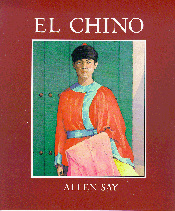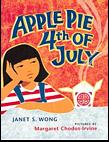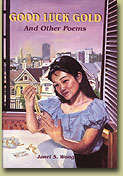![]()
Asian American Literature
 Say,
Allen. El Chino. Boston: Houghton-Mifflin, 1990. ISBN
0-395-52023-1.
Say,
Allen. El Chino. Boston: Houghton-Mifflin, 1990. ISBN
0-395-52023-1.
This is a story of perseverance and determination. This is also a story of breaking through barriers. This is the true story of Bong Way Wong, also known as Billy. Billy Wong was born in Arizona to Chinese immigrant parents. Billy's father was a hard-working grocer, who instilled in his children the message that they can be anything they want to be in America. At a young age, Billy decided he wanted to be a basketball player. His family la`In high school, he became a star player, but when he went on to college, Billy was told he was too short to play. Disappointed, he completed college and earned a degree in engineering, like his brother. On his first vacation, he traveled to Spain where he attended his very first bullfight. He immediately fell in love with the sport and decided he wanted to become a matador. He stayed on in Spain to study the sport. No one would give Billy the chance to prove himself and many people tried to discourage him, but he would not let their words dampen his dream. He found a Chinese costume, which helped draw attention to himself. He finally got the chance to prove himself as a skilled matador. A manager approached him and fitted him with a traditional Spanish matador costume and the rest was history! Billy Wong became the first Chinese American, Spanish matador despite being told, "Only the Spaniards can become true matadors."
Probably one of the most striking factors in this book are Say's watercolor illustrations. Say begins with black and white illustrations that take the reader through the early life of Billy Wong, which seems a bit bleak when his father dies and then when Billy is told he is too short to play college basketball. The black and white illustrations seem to project the disappointment and mundane parts of Billy's life. When Billy attends his first bullfight, however, full color illustrations burst forth! This signifies the excitement and hope that Billy experienced as he finds his true calling! The final illustration shows Billy being heralded by the people, realizing his dream of not only becoming a bullfighter, but of being accepted for what he truly wanted to be, even though it was something extraordinary!
This book is probably suited for grades 3-6, but it could be used at any level.
 Wong,
Janet S. Apple pie 4th of July. New York: Harcourt, 2002. ISBN
0-15-202543-X.
Wong,
Janet S. Apple pie 4th of July. New York: Harcourt, 2002. ISBN
0-15-202543-X.
A young Chinese American girl struggles with the fact that her immigrant parents do not seem to understand the 4th of July. There store is the only store in the neighborhood that remains open on this American holiday, as indicated in one of the illustrations. Her parents insist on cooking lots of Chinese food for the holiday. She tries to tell them that no one wants to eat Chinese food on an American holiday, but they continue. She sits around most of the afternoon, seemingly bored and slightly upset that she can't be a part of the celebration. Finally, at the end of the day, customers begin showing up for Chinese take-out. The line of customers wraps around the block! When the family closes the store for the day, they climb to the rooftop to watch the fireworks and eat apple pie. It is then that she (and hopefully the reader) realizes that America is truly the proverbial melting pot and its traditions stem from the many people who have brought their ideas here with them.
Wong opens the story with the girl expressing her dismay at the fact that her parents keep their store open 364 days per year, only closing on Christmas. The idea of having strong work ethics among Asian immigrants is depicted here. The story is set in modern-day urban America, as evidenced in the style of clothing worn by the characters, the buildings in the illustrations, and the images of the parade. Wong includes mention of some traditional Chinese foods: chicken chow mein, sweet-and-sour pork, etc. The contrasts in the food items (Chinese food vs. apple pie) shows the internal struggles the girl has in dealing with her two cultures.
The illustrations, by Margaret Chodos-Irvine, are done in a printmaking technique that almost looks like cut- or torn-paper. Cultural markers are evident throughout the book, beginning with the cover illustration which shows the young girl, decked out in red, white, and blue, sitting next to an open container of Chinese food. Another illustration includes a pair of chopsticks on the girl's plate of noodles, although at the end of the book, the girl is shown eating with a fork, again illustrating her dealing with both facets of her identity.
This story was done very well, on an easy to understand level for all readers. It is probably best suited for K-3, although it could certainly be used at all levels.
 Yep,
Laurence. Dragonwings. New York: Harper Collins, 1975. ISBN
0-329-02074-9.
Yep,
Laurence. Dragonwings. New York: Harper Collins, 1975. ISBN
0-329-02074-9.
This is another story of perseverance and determination, and of crossing cultural boundaries. Young Moon Shadow leaves China to be in America with his father, whom he has never met. They live together in the San Francisco area, with a group of T'ang men called the Company. They make a living washing and ironing the clothes of "the demons," the White people. Moon Shadow's father, Windrider, dreams of being able to fly. The two of them face many challenges together, including the anxiety of being separated from their wife and mother. Windrider wants his son to live safely, out of the reach of some of the unscrupulous people in the T'ang town. Breaking ties with the Company, Windrider and Moon Shadow move into "demon" territory and there they are befriended by Miss Whitlaw and her niece. The Whitlaws help Moon Shadow and his father in many ways. Moon Shadow tells Miss Whitlaw about his father's interest in flying and at his request she helps him compose a letter to the Wright Brothers. When Orville Wright responds to the letter, Windrider becomes more interested in trying to build a flying machine. The unlikely friendship between the Whitlaws and Moon Shadow and Windrider proves to be lasting as they endure the Great Earthquake together. Separated from the Whitlaws by soldiers during the post-earthquake reconstruction, Windrider and Moon Shadow move off on their own, where Windrider pursues his dream of flying. Cast into isolation and poverty, Moon Shadow stands by his father and helps him build a flying machine. When they are at the point of losing it all because they can't pay their rent, the Company comes around and helps Windrider with the manpower he needs to get his aeroplane up to the top of the hill. There, Moon Shadow and the Company all see Windrider experience his ultimate dream.
This story is filled with cultural references and markers. Yep uses vivid descriptions of the sights and sounds of turn of the century Chinatown. He tells the story through the eyes of the young boy, who is in a strange country, with a strange language, and living with virtually complete strangers. He compares the houses in the new land to those in his village and wonders how the "demons" could live in such drab, boxlike prisons. Yep includes a description of the story behind the T'and men wearing queues and . The inclusion of stories of dragons adds to the cultural experience.
Yep uses a very interesting strategy to signify when the characters are speaking English. This does not strike the reader until Miss Whitlaw is asking for a translation of what someone said. All of the dialogue in the story is happening in Chinese and when the characters speak English, Yep separates the dialogue by using italics. The italics are used for English words that Moon Shadow is experiencing for the first time, as well. For example, jin-jer-ber-ed, and gin-ger-bread, are shown when Moon Shadow experiences gingerbread cookies for the first time at Miss Whitlaw's house.
This story, aimed at the upper elementary grades, would be a great piece of literature to use in discussing the importance of Chinese immigrants in turn-of-the-century America.
 Wong,
Janet. Good luck gold and other poems. New York: McElderry Books,
1994. ISBN 0-689-50617-1.
Wong,
Janet. Good luck gold and other poems. New York: McElderry Books,
1994. ISBN 0-689-50617-1.
This book of 42 poems by Janet Wong shows the joys and tribulations of children of Asian descent, growing up in America. The subjects of the poems range from food to funerals. Some of the poems' themes focus on topics that are not unique to Asian American children, such as in Remembering When, a poem about a child who's mother drinks too much, or Orphan, a poem about a child who is bounced in and out of foster homes. The majority of the poems, however, deal with issues and experiences that are unique to Asian American children. The sights, sounds and traditions of Asian American communities come alive in poems like Deli Circus, where Wong describes the roast duck swinging back and forth on his "deli trapeze!" Some of the poems reflect strong family ties and respect for parents and grandparents. The poem, Jade, is a dialogue between a child and her grandmother, where the grandmother explains the significance of jade. Funeral explains a young girl's dismay at how her grandmother's body is made-up for the funeral and how she intends to help her grandmother "fix" the problem. In addition to these, there are poems that deal with issues such as the bigotry and racism. One such poem is Noise, where a child is being teased by other children about her eyes. Another poem that illustrates the racism faced in everyday situations is Waiting at the Railroad Cafe, where a child and her father are basically refused service at a cafe. The child rises above the bigotry and leads her father out of the situation with the statement, "Let's get out of this place. We're not equal, we're better."
The poems in this book are short, yet powerful. Difficult issues are dealt with in easy to read, easy to understand poems that children (and adults) of all ages would enjoy. Many of the poems can be shared aloud, while some might have a more profound effect if read independently and privately. Whoever the reader, and whatever his background or heritage, there is sure to be at least one poem in this collection that would touch the heart and maybe even enlighten the soul.
Although there are no illustrations in this book, the jacket illustration by James Hoston shows a young girl of Asian descent admiring a golden necklace. The illustration helps potential readers to know that the poems in this book are set in modern day America, probably San Francisco because of the Victorian style homes in the backdrop.